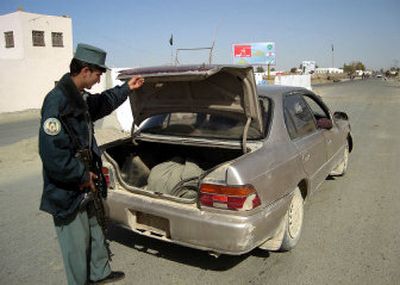Taliban say they’re ready for fight

KANDAHAR, Afghanistan – A top Taliban commander said Wednesday the group has 4,000 fighters bracing to rebuff NATO’s largest-ever offensive in southern Afghanistan, now in its second day.
Suicide bombers are ready, land mines have been planted and helicopters will be targeted, Mullah Abdul Qassim, a top Taliban commander in Helmand province, told the Associated Press. Qassim’s voice was recognized by an AP reporter who has spoken with him before.
NATO, meanwhile, announced the capture of a senior Taliban fighter who had eluded authorities by wearing a woman’s burqa. Mullah Mahmood, who is accused of helping Taliban fighters rig suicide bomb attacks, was seized by Afghan soldiers at a checkpoint near Kandahar, the alliance said.
Speaking by satellite telephone from an undisclosed location, Qassim said the Taliban has 8,000 to 9,000 fighters in Helmand province, including some 4,000 in the north, where NATO launched its largest-ever offensive Tuesday. He said all the fighters were Afghan, denying reports of hundreds of foreign fighters in the region.
“All of them are well-equipped and we have the weapons to target helicopters,” Qassim said. “The Taliban are able to fight for 15 or 20 years against NATO and the Americans.”
Operation Achilles, comprising some 4,500 NATO and 1,000 Afghan troops, is focused on securing lawless regions of northern Helmand – the world’s biggest poppy-growing region.
The offensive follows a mission last fall that wiped out hundreds of militants who fought in formation in neighboring Kandahar province, prompting NATO spokesman Col. Tom Collins to say this week the military would welcome a repeat of those tactics.
Qassim said the Taliban would adapt to conditions on the ground this time around.
“The Taliban know traditional fighting,” he said. “If we need to fight in a group, we will. If we need a suicide attack, we will do that. If we need ambushes and guerrilla fighting, we will do that.”
Collins said Wednesday that NATO was confident it would succeed in helping the government move into the region, though he said it would “take a while to get there.”
“We’ve established a presence and in some areas it’s a heavy presence, and we’re trying to disrupt the Taliban’s senior leadership in the area and try to separate them from trying to rally” the Taliban’s locally recruited soldiers, said Collins.
One British soldier and four Taliban fighters were killed during operations on Tuesday. NATO said it had no updates on the fighting late Wednesday.
Helmand is the world’s largest poppy-growing region, and U.N. officials say the Taliban derives tens – if not hundreds – of millions of dollars from the crop. NATO also says the Taliban is deeply involved in the drug trade, though Qassim denied that, saying the Taliban had eradicated opium poppies when it ruled Afghanistan from 1996-2001.
Mahmood – the Taliban commander caught wearing the burqa – was trying to leave the Panjwayi area of Kandahar province – site of the large NATO battle last fall where hundreds of Taliban fighters were killed.
“Alert (Afghan) soldiers at this checkpoint spotted the oddity and quickly arrested him,” NATO said.
In eastern Afghanistan, Afghan and U.S.-led coalition forces arrested a suspected al-Qaida bomb expert and five other terrorist suspects Wednesday.
Separately, U.S.-led coalition troops detained five men suspected of involvement in anti-government activities and “known terrorist groups,” in the eastern city of Khost, the coalition said.